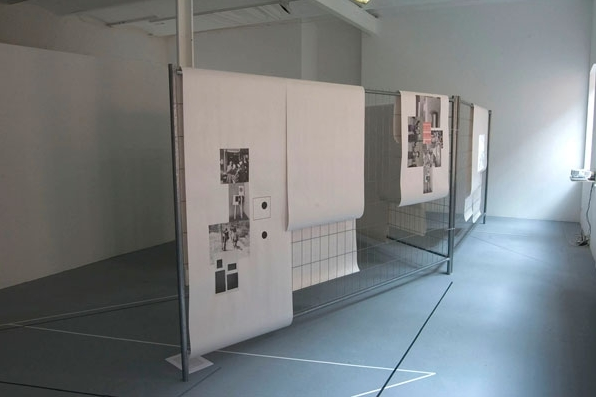TO SHOW IS TO PRESERVE
figures and demonstrations
Ein Projekt von
Martin Beck, Eva Birkenstock, Jörg Franzbecker, Max Hinderer, Heiko Karn, Hannes Loichinger, Katrin Mayer und Eske Schlüters
Halle für Kunst Lüneburg, 2008

Rezensionen:
Hans-Christian Dany erschienen in springerin 1/2009
Dirck Möllmann erschienen auf THE THING, Hamburg:
http://www.thing-hamburg.de/index.php?id=925
Henri Langlois, dem Mitbegründer und langjährigen Direktor der Cinémathèque française wird der Satz zugeschrieben ‚To show is to preserve‘. Darin kann das Verständnis einer Institution gesehen werden, das, mehr noch als im Archivieren, im Zeigen eine bewahrende Funktion erkennt. (In Folge unsachgemäßer Lagerung und wiederholt auftretenden Feuern in den Archiven der Cinémathèque gingen zahlreiche Filme für immer verloren.)
Der Ausstellung To Show is to Preserve – Figures and Demonstrations geht es darum, Praktiken des Zeigens auf den Ebenen des künstlerischen, theoretischen, kuratorischen und institutionellen Handelns zu befragen. Ein besonderes Interesse liegt dabei auf den produktiven, disseminativen und transformierenden Wirkungen des Zeigens.
Das Zeigen von etwas unterscheidet sich wesentlich vom Zeigen auf etwas. Eine Geste, die auf etwas zeigt, kann dessen Vorhandenheit in der Regel unproblematisch voraussetzen. Eine Geste, die etwas zeigt, bringt das Gezeigte als Ereignis möglicherweise erst hervor: Was wird also gezeigt, wenn etwas gezeigt wird?
In vielfältigen Bezügen steht das Zeigen zu Öffentlichkeiten, verstanden als Räume der Bewegung und Kommunikation, etwa in der Demonstration als politischer Protestform. Hier entstehen Strategien des Sichtbar-Werdens, die von Modellen der Repräsentation dazu übergehen, Repräsentationssysteme parasitär und uneindeutig zu bewohnen.
Entscheidend für das Zeigen ist auch die Frage nach den beteiligten Trägermedien, von Werbetafeln bis zu Kunstinstitutionen, und den damit verknüpften Dispositiven. Diese Träger unterliegen häufig dem Verdacht, im Akt des Zeigens zu interferieren oder das Gezeigte durch manipulative Effekte zu korrumpieren oder stillzustellen. Dies liegt nicht zuletzt daran, dass solche Medien in ihrer Funktion der Übertragung tendenziell unsichtbar werden. Wie können diese selbst sichtbar gemacht werden und was kann diese Sichtbarkeit bedeuten?
To Show is to Preserve – Figures and Demonstrations schafft eine installative Situation, in der sich Formen des Zeigens mit Fragen nach ihren gesellschaftlichen und materiellen Bedingungen zu einer spezifischen Gemengelage verbinden. Die Ausstellung ist eine konzeptuelle Zusammenarbeit von KünstlerInnen, KuratorInnen und TheoretikerInnen.
– – – –
Henri Langlois, co-founder and long-standing director of the Cinémathèque française, is attributed the phrase ‘To show is to preserve’. This expresses the understanding of an institution that sees a preserving function in showing, even more than in archiving. (As a result of improper storage and repeated fires in the archives of the Cinémathèque, numerous films were lost forever.)
The exhibition To Show is to Preserve – Figures and Demonstrations is concerned with questioning practices of showing on the levels of artistic, theoretical, curatorial, and institutional activities. Particular interest lies in the productive, disseminating and transforming effects of showing.
Showing something differs essentially from pointing to something. A gesture that points to something can usually presuppose the existence of what it points to without problems. A gesture that shows something possibly produces what is shown as an event: So what is shown when something is shown?
An important question is raised by the different relations of showing to public spheres, as spaces of movement and communication, the way they are realized, for example, in political protest in the form of a demonstration. What emerges here are strategies of becoming visible that undergo a change from being models of representation to inhabiting systems of representation in a parasitic and ambiguous way.
Finally, showing also stands in relation to mediums, from the advertising billboard all the way to art institutions, along with the dispositifs linked to them. These mediums are often subject to the suspicion of interfering in the act of showing, or of corrupting or paralysing what is shown through manipulative effects. The reason for this lies not least in the fact that such mediums tend to make themselves invisible in regard to their function of transferral. How can they be made visible and what can the meaning of this visibility be?
To Show is to Preserve – Figures and Demonstrations creates an installation situation in which forms of showing are connected with questions related to their social and material conditions, resulting in a specific overlapping patchwork. The exhibition is a conceptual collaboration between artists, curators and theorists.
EVENING EVENTS
Thursday, October 9th 2008, 7 pm
Passing the Rainbow, a film project on actresses and ways to escape gender roles in Afghan society, screening and discussion with Sandra Schaefer (artist, Berlin)
Thursday, September 23rd, 2008, 7 pm
Was Du wissen solltest (Die Zukunft) [What You Should Know (The Future)], a lecture on Leipzig Airport, soldiers as transit passengers and the difference between civilian and military processes, by Jan Caspers (artist, Leipzig), Anne Koenig (artist/publicist, Leipzig), Vera Tollmann (curator, Berlin), and Jan Wenzel (artist/publicist, Leipzig)
Thursday, November 13th, 2008, 7 pm
How to Climb a Fence – Figures and Demonstrations, You/Tube/Stream-Evening
Publikation erschienen im textem Verlag, Hamburg:
http://www.textem.de/index.php?id=1730
Mit Texten von Dirck Möllmann und Hans-Christian Dany
Noch erhältliche Jahresgabe:
https://www.halle-fuer-kunst.de/jahresgaben/to-show-is-to-preserve-figures-and-demonstrations/
Fotos: Heiko Karn







